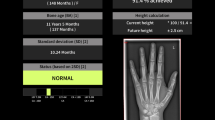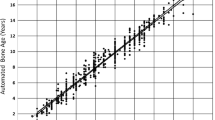Abstract
Background
Bone age in children is mainly assessed using the Greulich and Pyle (GP) atlas, a validated method with limited interobserver accuracy. While automated methods increase interobserver accuracy, they represent considerable costs and technical requirements.
Objective
A proof-of-concept study to create and evaluate an online software program, Boneureka©, based on linear metacarpal length measurements, to assess bone age in healthy children.
Materials and methods
The study retrospectively included 434 consecutive children (215 girls) who underwent a left-hand radiograph to rule out trauma between March 2008 and December 2017. Two reviewers measured the second to fourth metacarpal lengths on each radiograph and the distance between the centre of the epiphyses of the second and fifth metacarpals. A single reviewer estimated the bone age using the GP atlas. The automated software assessed the bone age for all radiographs. A mathematical model was developed based on linear regressions to provide the mean bone age and standard deviation based on the estimates. Pearson and intraclass correlation coefficient (ICC) were used to evaluate the correlation and agreement between the estimated bone ages using Boneureka©, the GP atlas and BoneXpert® compared to chronological age.
Results
The measure that showed the highest correlation (r2=0.877 for girls and r2=0.834 for boys; P<.001) and the highest ICC (ICC=0.937 for girls and ICC=0.926 for boys; P<0.001) with chronological age was length of the second metacarpal. The GP atlas and the automated software evaluation had excellent ICC with chronological age (ICC>0.95 for both methods and sexes). Using this data, we created an online software program based on the second metacarpal length to obtain bone age estimates, means and standard deviations.
Conclusion
The newly created online software Boneureka,© based on the second metacarpal length, is a reliable and user-friendly tool to assess bone age in healthy children. Further studies on a larger population should be performed to validate the developed reference values.






Similar content being viewed by others
References
Vicente Gilsanz, Osman Ratib (2005) Hand bone age, Springer. Springer-Verlag Berlin Heidelberg New York, Germany
Greulich WW, Pyle SI (1959) Radiographic atlas of skeletal development of the hand and wrist, 2nd edition. Stanford University Press, Stanford, CA
Tanner J, Whitehouse R, Cameron N et al (1983) Assessment of Skeletal maturity and prediction of adult height, 2nd edn. Academic Press, London
Bull RK, Edwards PD, Kemp PM et al (1999) Bone age assessment: a large scale comparison of the Greulich and Pyle, and Tanner and Whitehouse (TW2) methods. Arch Dis Child 81:172–173
De Sanctis V, Soliman AT, Di Maio S et al (2014) Are the new automated methods for bone age estimation advantageous over the manual approaches? Pediatr Endocrinol Rev PER 12:200–205
Thodberg HH (2009) An automated method for determination of bone age. J Clin Endocrinol Metab 94:2239–2244
Boitsios G, Leucio AD, Preziosi M et al (2021) Are automated and visual Greulich and Pyle-based methods applicable to Caucasian European children with a Moroccan ethnic origin when assessing bone age? Cureus. https://doi.org/10.7759/cureus.13478
van Rijn RR, Thodberg HH (2013) Bone age assessment: automated techniques coming of age? Acta Radiol Stockh Swed 1987 54:1024–1029
Eng DK, Khandwala NB, Long J et al (2021) Artificial intelligence algorithm improves radiologist performance in skeletal age assessment: a prospective multicenter randomized controlled trial. Radiology 301:692–699
Martin DD, Heckmann C, Jenni OG et al (2011) Metacarpal thickness, width, length and medullary diameter in children–reference curves from the First Zürich Longitudinal Study. Osteoporos Int J Establ Result Coop Eur Found Osteoporos Natl Osteoporos Found USA 22:1525–1536
Haghnegahdar A, Pakshir H, Ghanbari I (2019) Correlation between skeletal age and metacarpal bones and metacarpophalangeal joints dimensions. J Dent Shiraz Iran 20:159–164
Tsai A, Stamoulis C, Bixby SD et al (2016) Infant bone age estimation based on fibular shaft length: model development and clinical validation. Pediatr Radiol 46:342–356
Rosner B (2016) Fundamentals of biostatistics, 8th edition. Cengage Learning, Boston, MA
Bayley N, Pinneau SR (1952) Tables for predicting adult height from skeletal age: revised for use with the greulich-pyle hand standards. J Pediatr 40:423–441
Zhang A, Sayre JW, Vachon L et al (2009) Racial differences in growth patterns of children assessed on the basis of bone age1. Radiology 250:228–235
Martin DD, Heckmann C, Jenni OG et al (2011) Metacarpal thickness, width, length and medullary diameter in children—reference curves from the First Zürich Longitudinal Study. Osteoporos Int 22:1525–1536
Author information
Authors and Affiliations
Corresponding author
Ethics declarations
Conflicts of interest
None
Ethics approval
This study was performed in line with the principles of the Declaration of Helsinki and institutional Ethics Committee approval.
Consent to participate
Informed consent was waived due to the retrospective and observational nature of the study.
Additional information
Publisher's note
Springer Nature remains neutral with regard to jurisdictional claims in published maps and institutional affiliations.
Rights and permissions
Springer Nature or its licensor (e.g. a society or other partner) holds exclusive rights to this article under a publishing agreement with the author(s) or other rightsholder(s); author self-archiving of the accepted manuscript version of this article is solely governed by the terms of such publishing agreement and applicable law.
About this article
Cite this article
Boitsios, G., Briganti, G., Mokhtari, A. et al. Online software Boneureka assessing bone age based on metacarpal length in healthy children: proof-of-concept study. Pediatr Radiol 53, 1100–1107 (2023). https://doi.org/10.1007/s00247-023-05595-9
Received:
Revised:
Accepted:
Published:
Issue Date:
DOI: https://doi.org/10.1007/s00247-023-05595-9




